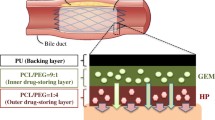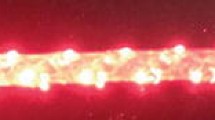Abstract
This study aimed to investigate the drug delivery efficacy and bio-effectiveness of a novel photodynamic therapy (PDT)-matrix drug delivery system for cholangiocarcinoma (CCA). Metallic stents were coated with polyurethane (PU) as the first layer. A 2-hydroxyethyl methacrylate (2-HEMA)/ethylene glycol dimethacrylate (EGDMA)/benzoyl peroxide (BPO) layer and a poly(ethylene-co-vinyl acetate) (PEVA)/poly(n-butyl methacrylate) (PBMA)/polyvinylpyrrolidone K30 (K30) layer containing various concentrations of Photofrin were then incorporated onto the stent as the second and third layers. After incubating the layered membranes with cultured CCA cell line, the release of Photofrin, cell viability, the intracellular uptake of Photofrin, reactive oxygen species (ROS) generation, and apoptosis were determined. Using a single-layer diffusion model, the maximum release of Photofrin from the 5 to 10% K30 formulas was 80 and 100%, respectively, after 24 h. When using the multiple-layer diffusion model, the released Photofrin showed an initial burst of the loading dose from the PEVA/PBMA/K30 layer. In the immobilized model, less than 5% of the Photofrin from the 2-HEMA/EGDMA/BPO layer was released over the 24-h period. Cell viability decreased linearly with increasing Photofrin concentrations, and ROS generation and apoptosis were shown to increase significantly with increasing Photofrin concentrations, until the concentration of Photofrin reached a saturation point of 1.5 μg/ml. This new, multiple-layered, PDT-based stent with dual-release mechanisms is a promising treatment for CCA and cancer-related ductal stenosis.





Similar content being viewed by others
Abbreviations
- 2-HEMA:
-
2-hydroxyethyl methacrylate
- BPO:
-
Benzoyl peroxide
- CCA:
-
Cholangiocarcinoma
- DDS:
-
Drug delivery system
- DES:
-
Drug-eluting stent
- EGDMA:
-
Ethylene glycol dimethacrylate
- K30:
-
Polyvinylpyrrolidone K30
- PBMA:
-
Poly(n-butyl methacrylate)
- PDT:
-
Photodynamic therapy
- PEVA:
-
Poly(ethylene-co-vinyl acetate)
- ROS:
-
Reactive oxygen species
References
C.D. Anderson, C.W. Pinson, J. Berlin, R.S. Chari, Oncologist 9, 43–57 (2004)
T.H. Baron, Clin. Gastroenterol. Hepatol. 6, 266–267 (2008)
A.P. Castano, P. Mroz, M.R. Hamblin, Nat. Rev. Cancer 6, 535–545 (2006)
P. Chahal, T.H. Baron, Curr. Opin. Gastroenterol. 22, 551–560 (2006)
J.L. Cheng, M.J. Bruno, J.J. Bergman, E.A. Rauws, G.N. Tytgat, K. Huibregtse, Gastrointest. Endosc. 56, 33–39 (2002)
Y.K. Cheon, T.Y. Lee, S.M. Lee, J.Y. Yoon, C.S. Shim, HPB (Oxford) 14, 185–193 (2012)
D. Fuks, E. Bartoli, R. Delcenserie, T. Yzet, P. Celice, C. Sabbagh, D. Chatelain, J.P. Joly, N. Cheron, J.L. Dupas, J.M. Regimbeau, J. Gastroenterol. Hepatol. 24, 1745–1752 (2009)
F. Gao, Y. Bai, S.R. Ma, F. Liu, Z.S. Li, J. Hepatobiliary Pancreat. Sci. 17, 125–131 (2010)
M.F. Gerhards, D. den Hartog, E.A. Rauws, T.M. van Gulik, D. Gonzalez Gonzalez, J.S. Lameris, L.T. de Wit, D.J. Gouma, Eur. J. Surg. 167, 274–280 (2001)
G.C. Harewood, T.H. Baron, A. Rumalla, K.K. Wang, G.J. Gores, L.M. Stadheim, P.C. de Groen, J. Gastroenterol. Hepatol. 20, 415–420 (2005)
P. Harrod-Kim, J. Vasc. Interv. Radiol. 17, 1441–1448 (2006)
A. Hoblinger, T. Gerhardt, M.A. Gonzalez-Carmona, R. Huneburg, T. Sauerbruch, V. Schmitz, Eur. J. Med. Res. 16, 391–395 (2011)
W.R. Jarnagin, Y. Fong, R.P. DeMatteo, M. Gonen, E.C. Burke, B.J. Bodniewicz, B.M. Youssef, D. Klimstra, L.H. Blumgart, Ann. Surg. 234, 507–517; discussion 517–509 (2001)
T.G. Kim, H. Lee, Y. Jang, T.G. Park, Biomacromolecules 10, 1532–1539 (2009)
J.W. Lee, S.G. Yang, K. Na, Int. J. Pharm. 427, 276–283 (2012)
A. Leunig, F. Staub, J. Peters, A. Heimann, O. Kempski, A.E. Goetz, Res. Exp. Med. (Berl) 193, 361–370 (1993)
R.C. Martin 2nd, G.C. Vitale, D.N. Reed, G.M. Larson, M.J. Edwards, K.M. McMasters, Surg. Endosc. 16, 667–670 (2002)
H. Moole, H. Tathireddy, S. Dharmapuri, V. Moole, R. Boddireddy, Y. Yedama, S. Dharmapuri, A. Uppu, N. Bondalapati, A. Duvvuri, World J. Gastroenterol. 23(7), 1278–1288 (2017)
S. Moon, S.G. Yang, K. Na, Biomaterials 32, 3603–3610 (2011)
M.A. Ortner, Curr. Opin. Gastroenterol. 25, 472–476 (2009)
P. Singh, T. Patel, Curr. Opin. Gastroenterol. 22, 294–299 (2006)
Y. Tomizawa, J. Tian, Dig. Dis. Sci. 57, 274–283 (2012)
J. Valle, H. Wasan, D.H. Palmer, D. Cunningham, A. Anthoney, A. Maraveyas, S. Madhusudan, T. Iveson, S. Hughes, S.P. Pereira, M. Roughton, J. Bridgewater, N. Engl. J. Med. 362, 1273–1281 (2010)
H. Witzigmann, F. Berr, U. Ringel, K. Caca, D. Uhlmann, K. Schoppmeyer, A. Tannapfel, C. Wittekind, J. Mossner, J. Hauss, M. Wiedmann, Ann. Surg. 244, 230–239 (2006)
J.J. Yoo, C. Kim, C.W. Chung, Y.I. Jeong, D.H. Kang, Int. J. Nanomedicine 7, 1997–2005 (2012)
T. Zoepf, R. Jakobs, J.C. Arnold, D. Apel, A. Rosenbaum, J.F. Riemann, Am. J. Gastroenterol. 96, 2093–2097 (2001)
Acknowledgements
This study was supported by the National Research Program for Biopharmaceuticals (NRPB), Republic of China (R.O.C.), Taiwan (Project No. 100INP015-1 and 100INP015-2). The stent used in this study was provided by Professor Fuh-Yu Chang, Department of Mechanical Engineering, National Taiwan University of Science and Technology.
Author information
Authors and Affiliations
Corresponding author
Ethics declarations
Conflict of interest
The authors declare no financial or commercial conflict of interest.
Rights and permissions
About this article
Cite this article
Liang, PC., Huang, KW., Tung, CC. et al. A novel photodynamic therapy-based drug delivery system layered on a stent for treating cholangiocarcinoma. Biomed Microdevices 20, 3 (2018). https://doi.org/10.1007/s10544-017-0249-1
Published:
DOI: https://doi.org/10.1007/s10544-017-0249-1




